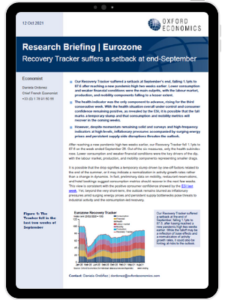Eurozone | Recovery Tracker suffers a setback at end-September

Our Recovery Tracker suffered a setback at September’s end, falling 1.1pts to
87.6 after reaching a new pandemic high two weeks earlier. Lower consumption and weaker financial conditions were the main culprits, with the labour market, production, and mobility components falling to a lesser extent.
The health indicator was the only component to advance, rising for the third
consecutive week. With the health situation overall under control and consumer confidence remaining positive, as revealed by the ESI.
What you will learn:
- Inflationary pressures accompanied by surging energy
prices and persistent supply-side disruptions threaten the outlook - Lower consumption and weaker financial conditions were the key drivers of the dip, with the labour market, production, and mobility components representing smaller drags
- It it is possible that the fall marks a temporary slump and that consumption and mobility metrics will recover in the coming weeks
Tags:
Related Services

Post
Food prices to bottom out in 2024, risks skewed to upside
Our baseline forecast is for world food commodity prices to register an annual decline this year, in aggregate, reducing pressure on food retail prices further downstream. However, we believe the risks to this forecast are overwhelmingly skewed to the upside.
Find Out More
Post
Battery raw material prices to recover
Battery raw materials prices bottomed out last quarter and we think a sustained recovery is looming. Midstream EV battery manufacturing activity has picked up again and inventories have returned to historical levels, suggesting upstream demand for raw materials will also bounce back.
Find Out More